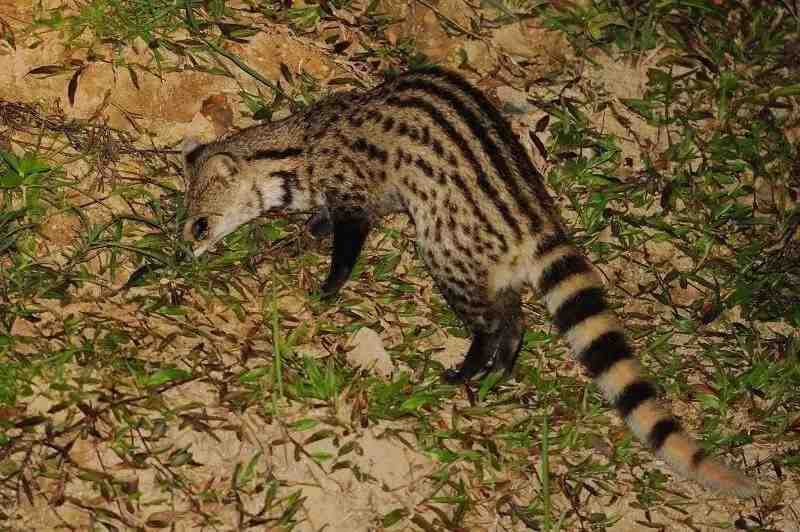Viverra zibetha
IUCN
LCBasic Information
Scientific classification
- name:Viverra zibetha
- Scientific Name:Big civet, Jiujiang civet, Nine-section civet,Large Indian civet
- Outline:Carnivora
- Family:Carnivora Viverridae Viverra
Vital signs
- length:60-80cm
- Weight:6-10kg
- lifetime:15year
Feature
It has a special directional ability and knows how to use the civet scent secreted by the cystic scent glands to guide it.
Distribution and Habitat
It is mainly distributed in broad-leaved forests, bushes and farming areas in South Asia and Southeast Asia, including China, Indonesia, India, Bangladesh, Bhutan, Sikkim, Nepal, Myanmar, Cambodia, Laos, Malaysia, Thailand, Vietnam, etc.
In China, it is widely distributed in tropical and subtropical regions, including southern Gansu, Sichuan, Qinling Mountains in Shaanxi, southern Anhui, Zhejiang, Fujian, Jiangxi, Hubei, Hunan, Guangdong, Hainan, Guangxi, Guizhou, Yunnan and low-altitude areas in southeastern Tibet (Zayu, Bomi, Medog, Nyingchi, Milin, Cona, etc.).
The civet mainly lives in tropical rainforests, subtropical evergreen broad-leaved forests, bushes and grass in hills and mountains below 2,100 meters above sea level, and chooses rock caves, earth holes or tree holes as habitats.
Appearance
The civet is slender, much larger than a domestic cat, and similar in size to a domestic dog. An adult weighs 6 to 10 kilograms, is 60 to 80 centimeters long, and can be up to 100 centimeters long. It has a slightly pointed head, small ears, a wide forehead, a slightly protruding snout, and claws made of skin flaps on the third and fourth toes of the front feet. The body hair is brown-gray with black-brown markings, the lips are grayish white, and there are small grayish-white pockmarks around the forehead and eyes. There is a black vertical stripe composed of coarse bristles from the center of the back to the base of the tail. There are three prominent wavy black collar stripes on the sides of the neck and throat, with wide white stripes in between, and the belly hair is light gray. The limbs are short, black-brown, and the tail is more than half the length of the body. The tail has 5 to 6 black and white rings, with black ends.
The male civet has a pair of well-developed sac-like
Details
There are 12 subspecies of the civet cat.

The civet cat is solitary by nature, likes to walk at night, is alert by nature, has very sensitive hearing and smell, hides during the day and comes out at night, is agile in action, has sensitive hearing, is cunning and suspicious, so it is called a fox cat. During the day, it hides in bushes, grass, tree holes, earth holes, and rock caves. It starts to move at dawn and dusk, often foraging at the edge of the forest, near farmland, valleys, and even near settlements, and returns to its habitat two or three hours later. Except for the breeding season, it basically lives alone.
The civet is good at climbing trees and swimming. It often wades into the water to catch prey, but it mainly moves on the ground. There are fixed defecation places in the activity area, and its activity intensity can be inferred based on the excrement. When encountering an enemy, it can release extremely smelly substances for self-defense. When hunting, it often uses ambushes, sometimes submerging its body between its feet, crawling through the grass like a snake, quietly approaching the prey, and suddenly rushing out to prey.
The civet cat has a special directional ability, which is guided by the civet scent secreted by the sac-shaped scent gland. When it is active, it often smears the tree trunks, wooden stakes, stone edges and other protruding objects along the way with the secretion of the scent gland, commonly known as "rubbing the stakes". This rubbing behavior plays a role in marking the territory and also serves as a contact with other civet cats. When it obtains food or encounters an enemy, it can return to the cave accurately along the route indicated by the left mark at the fastest speed. The characteristics of this secretion are that the smell is highly volatile and lasts for a long time, which is just suitable for the civet cat to get information at a certain distance from the cave, or when there are plant obstacles in the space, or when the time interval is longer.
The fur of the civet cat is thick and dense, with a base fleece, which can be made into collars, hats, etc. after dyeing. Civet is a valuable spice and can also be used as medicine. Therefore, the annual hunting volume exceeds the population growth volume. Overhunting, habitat loss, and the use of highly toxic rodenticides, which lead to secondary poisoning, have led to the endangered species.
Listed in Appendix III of the Convention on International Trade in Endangered Species of Fauna and Flora (CITES).
Listed in the first level of the "List of National Key Protected Wildlife in China".
Protect wildlife and eliminate game.
Maintaining ecological balance is everyone's responsibility!








